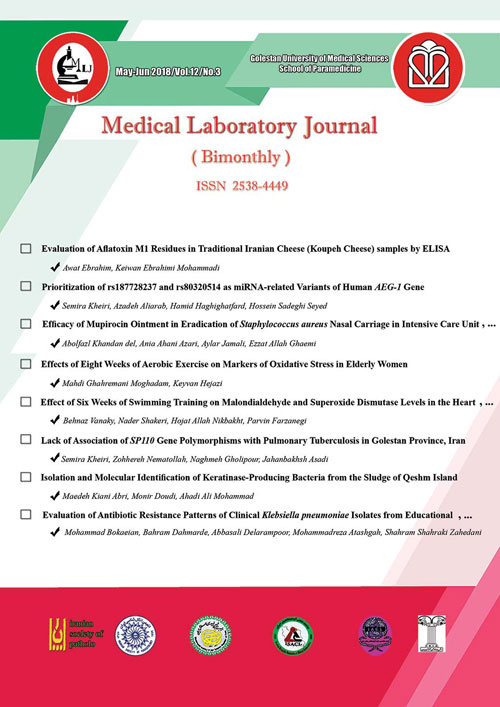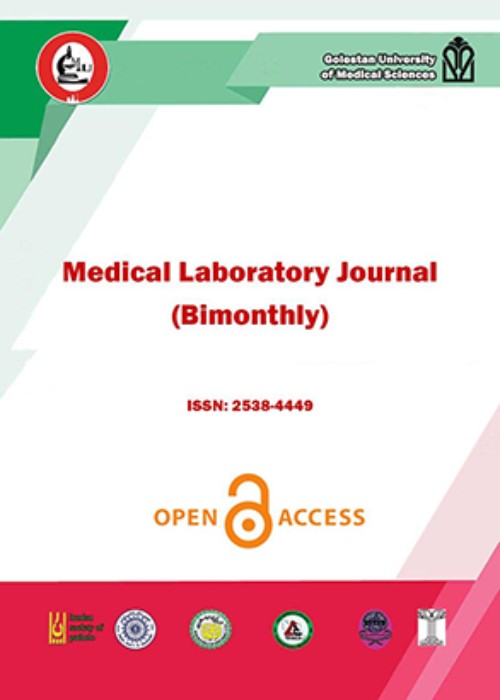فهرست مطالب

Medical Laboratory Journal
Volume:12 Issue: 3, May-Jun 2018
- تاریخ انتشار: 1397/04/19
- تعداد عناوین: 8
-
-
Pages 1-5Background And ObjectivesLocal cheese made from raw milk is one of the most commonly consumed dairy products in the world. Mycotoxin contamination of foodstuff and its transmission to consumers are extremely important public health issues. The purpose of this survey was to determine the level of aflatoxin M1 (AFM1) residues in Koupeh cheese, a traditional fermented Iranian cheese produced in spring and summer.
MethodsWe randomly collected 48 local cheese samples produced in Mahabad (northwest of Iran) during spring and summer. The level of AFM1 was measured by enzyme-linked immunosorbant assay using commercial kits and a microplate reader.
ResultsAll samples contained measurable amounts of AFM1. Cow milk cheese samples contained higher level of AFM1 compared to sheep milk cheese samples. The level of AFM1 in the samples from both animals was lower in summer. There was no significant difference between the mean level of AFM1 in summer and spring. Moreover, 33.3% of cow milk cheese samples collected in spring and 16.6% of the samples collected in summer contained toxin levels higher than the maximum allowed concentration set by the European Commission (250 ng/Kg) and by the Institute of Standards and Industrial Research of Iran (200 ng/Kg).
ConclusionThe results of this study show that the level of AFM1in Koupeh cheese is influenced by the livestock type and production season, in a way that the level of contamination is higher in spring.Keywords: Cheese, Cultured Milk Products, Aflatoxin M1, ELISA -
Pages 6-11Background And Objectives3' untranslated region (3'UTR) single nucleotide polymorphisms (SNPs) represent genetic variations that may potentially affect binding of miRNA to coding genes, potentially leading to complex disorders. We aimed to perform in silico analysis of the potential phenotypic effect of 3'UTR SNPs on human astrocyte elevated gene-1 (AEG-1), a newly identified candidate cancer gene.
MethodsWe gathered a list of all 3'UTR SNPs located in the human AEG-1 gene from the SNP database. Analysis of the potential effects was done using MirSNP and MicroSNiper.
ResultsAnalysis by the MirSNP estimated that rs187728237 might increase the affinity of two miRNAs and decrease the affinity of 10 other miRNAs to the AEG-1 transcript. Moreover, MicroSNiPer showed that rs80320514 might affect 24 putative miRNA binding sites in the 3'UTR of AEG-1.
ConclusionBased on our findings, it can be concluded that the 3'UTR SNPs located in the human AEG-1 gene may be within the miRNA targets of the transcript, therefore affecting the stability of putative miRNA-target interactions.Keywords: AEG-1, miRNA, SNPs, 3 Untranslated Region -
Pages 12-16Background And ObjectivesStaphylococcus aureus is one of the most common causes of morbidity and mortality among intensive care unit (ICU) patients. Nasal carriage is one of the main routs of S. aureus transmission between hospital personnel and patients. The objective of this study was to evaluate the efficacy of mupirocin ointment in eradication of nasal carriage of S. aureus in the ICU staff and patients of Panje-Azar hospital in Gorgan, Iran.
MethodsIn the first three months of the study (January to March), the prevalence of S. aureus among ICU patients was determined by routine microbiological and biochemical testing. Nasal samples were taken from ICU staff and all patients recently admitted to the ICU. Mupirocin nasal ointment (2%) was applied for treatment of S. aureus nasal carriers. Post-treatment sampling was done after five weeks. During the next three months, the presence of S. aureus and rate of resistance to methicillin was evaluated in new patients admitted to the ICU using the method used previously.
ResultsOf 60 samples from the ICU staff, seven (11.7%) samples were positive for S. aureus. Moreover, of 240 samples from the ICU patients, two samples were found as S. aureus-positive. Of the nine S. aureus-positive isolates, only two (22.2%) were methicillin-resistant S. aureus (MRSA). In the pre-intervention sampling, only five samples (2.8%) were identified as S. aureus, two of which were MRSA. However, treatment with mupirocin ointment eradicated nasal carriage of S. aureus and no isolate was found after the intervention.
ConclusionOur finding showed that mupirocin nasal ointment is highly effective in eradication of S. aureus nasal carriage and subsequently contribute to reduction in frequency of nosocomial infections in the ICU.Keywords: Intensive Care Units, Mupirocin, Nasal, Staphylococcus aureus -
Pages 17-23Background And ObjectivesOxidative stress is a common mediator in pathogenicity of established cardiovascular risk factors. The purpose of this study was to determine effects of selected aerobic training on some oxidative stress indicators in sedentary elderly women.
MethodsIn this quasi-experimental study, 21 participants (age range: 60-70 years) were selected by convenience sampling and then randomly assigned to an exercise group (n=11) and a control group (n=10). Aerobic exercise was performed at 50-70% of heart rate reserve for 45-60 minutes per session, three sessions a week, for eight weeks. Blood samples were taken at baseline and 24 hours after the last training session. Within-group and between-group differences were assessed using paired sample t-test and independent t-test, respectively. Statistical significance level was set at 0.05.
ResultsWeight, body mass index and body fat percentage decreased significantly after the exercise intervention (PConclusionIt seems that regular aerobic exercise at moderate intensity can improve antioxidative capacity and reduce the risk of cardiovascular disease in elderly women.Keywords: Endothelin-1, 8-hydroxydeoxyguanosine, Exercise, Elderly -
Pages 24-29Background And ObjectivesBreast cancer is one of the most common cancers among women. Cardiovascular disease is one of the most important complications of breast cancer. The aim of this study was to investigate the effects of six weeks of swimming on malondialdehyde (MDA) and superoxide dismutase (SOD) levels in the heart tissue of mice with breast cancer.
MethodBreast cancer was induced in 30 female Balb/c mice (6-8 weeks old, weighing 150-200 g) by tumor transplantation. The tumor site was examined every day for the formation or absence of tumor. After becoming familiar with the laboratory environment and swimming pool, the subjects were randomly divided into three equal groups: 1. healthy control, 2. cancer control, and 3. swimming-cancer. The swimming group performed swimming training 60 minutes/day, five days a week, for six weeks. After the intervention, the levels of SOD and MDA in the heart tissue samples were evaluated by enzyme-linked immunosorbent assay. Data were analyzed in SPSS (version 16) using independent t-test at significance of 0.05.
ResultsThe results showed that induction of breast cancer was accompanied by a significant increase in MDA and a significant decrease in SOD in the heart tissue of mice. Participation in the six-week swimming significantly reversed these effects.
ConclusionSwimming could have beneficial effects in improving oxidative factors in breast cancer patients.Keywords: Breast Neoplasms, Heart, Malondialdehyde, Superoxide Dismutase, Swimming -
Pages 30-33Background And ObjectivesMycobacterium tuberculosis is the causative agent of pulmonary tuberculosis, a main public health problem that results in 1.5 million deaths annually. A number of epidemiological studies suggested that host genetic factors could play a main role in susceptibility to tuberculosis infection.
SP110 is an interferon-induced nuclear body protein with vital roles in apoptosis, cell cycling and immunity. SP110 gene has been suggested to be a suitable candidate for limiting TB infections. Thus, we investigated the possible association between SP110 gene polymorphisms and susceptibility to tuberculosis in the Golestan Province, Iran.
MethodsWe investigated the frequency of rs1135791 polymorphism of the SP110 gene among 100 pulmonary tuberculosis patients and 100 healthy individuals who were referred to the health centers in the Golestan Province (Iran) between 2014 and 2015. Frequency of genotypes was evaluated using amplification refractory mutation system-polymerase chain reaction.
ResultsThe frequency distribution of TT, TC and CC genotypes among the patients was 65%, 31% and 4%, respectively. In the control group, the frequency distribution of TT, TC and CC genotypes was 56%, 46% and 7%, respectively. There was no significant difference in the frequency of rs1135791 between the patients with pulmonary tuberculosis and the healthy controls (P=0.42).
ConclusionBased on the results, the SP110 rs1135791 variant is not a genetic risk factor for development of pulmonary tuberculosis in Golestan Province, Iran.Keywords: rs1135791T, Pulmonary tuberculosis, Golestan Province -
Pages 34-40Background And ObjectivesKeratinase is an enzyme commonly used in the production of detergents, cosmetics, drugs, leather, and other industries. Considering the high cost of traditional methods for decomposition of feather, hair, hooves, nails, and wool that contain high levels of keratin, their biodegradation with keratinase-producing bacteria can be a valuable solution. The present study aimed for isolation and molecular identification of keratinase-producing bacteria in Qeshm Island and Peyposht village in Iran.
MethodsWater and sludge samples from the Qeshm Island and Peyposht village were collected. The bacteria isolates were screened for keratinase production using the Lowry method. Effect of pH and temperature was assessed on the production of keratinase and on the growth of the isolates. Colony-polymerase chain reaction was used for molecular identification of the isolates.
ResultsBacillus berevis and Enterobacter cloacae were isolated in this study. Keratinase production in B. berevis was highest at pH 7.5 and 35 °C. In addition, the highest level of enzyme production by E. cloacae was observed at pH 7 and 37 °C.
ConclusionIt seems that the bacterial strains isolated from sludge in the study area have relatively favorable keratinase production capacity.Keywords: Bacteria, Colony PCR, Identification, Keratinolytic protein, Sewage -
Pages 41-45Background And ObjectivesThe resistance of gram-negative bacteria to antibiotics has become a serious problem, which imposes a significant increase in treatment costs. Klebsiella pneumoniae is an important nosocomial pathogen from the Enterobacteriaceae family. The aim of this study was to investigate the frequency and pattern of antibiotic resistance in K. pneumoniae strains isolated from clinical samples.MethodsThis descriptive, cross-sectional study was performed on 150 K. pneumonia strains isolated from different clinical samples such as urine, sputum, blood, ulcers, lung secretions and abdominal abscess. Antibiogram test was performed using the disk diffusion method (Kirby-Bauer). Minimum inhibitory concentration of amikacin, tobramycin and gentamicin was determined via the E-test for 50 strains with high resistance rates.ResultsIn this study, the highest rate of resistance was observed against carbenicilin, ceftriaxone, cefepime and streptomycin. K. pneumonia isolates were most frequent in urine and sputum samples. In the E-test, the highest rate of resistance was observed against gentamicin, tobramycin (16µg/ml) and amikacin (64µg/ml).ConclusionBased on our results, tigecycline, netilmicin, kanamycin and amikacin are the most effective antibiotics for the treatment of K. pneumoniae infections.Keywords: Klebsiella pneumoniae, antimicrobial resistance, E-test method


